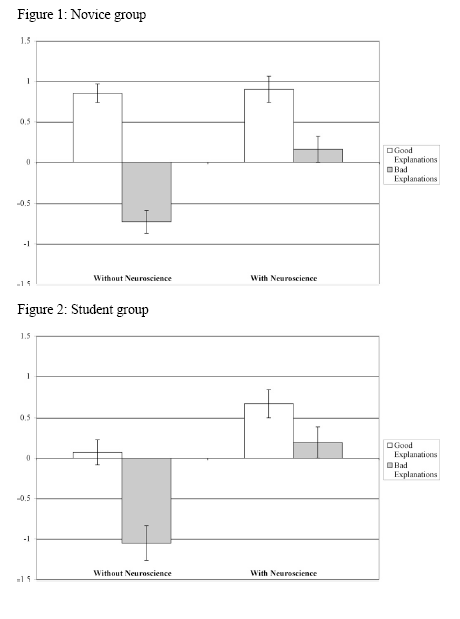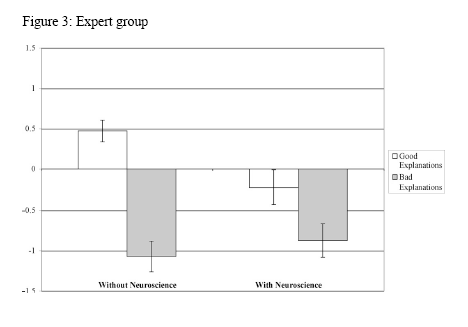June 06, 2007
Distracted by the brain
About a year ago, I referred readers to Paul Bloom's discussion of Deena Skolnick's study of how mixing in a bit of irrelevant talk about neuroscience "turned bad [psychological] explanations into satisfactory ones" ("Blinded by neuroscience", 6/28/2006). Now a paper documenting that research is in press: Deena Skolnick Weisberg, Frank C. Keil, Joshua Goodstein, Elizabeth Rawson, & Jeremy R. Gray, "The seductive allure of neuroscience explanation", Journal of Cognitive Neuroscience. Here's the abstract:
Explanations of psychological phenomena seem to generate more public interest when they contain neuroscientific information. Even irrelevant neuroscience information in an explanation of a psychological phenomenon may interfere with people’s abilities to critically consider the underlying logic of this explanation. We tested this hypothesis by giving naïve adults, students in a neuroscience course, and neuroscience experts brief descriptions of psychological phenomena followed by one of four types of explanation, according to a 2 (good explanation vs. bad explanation) x 2 (without neuroscience vs. with neuroscience) design. Crucially, the neuroscience information was irrelevant to the logic of the explanation, as confirmed by the expert subjects. Subjects in all three groups judged good explanations as more satisfying than bad ones. But subjects in the two non-expert groups additionally judged that explanations with logically irrelevant neuroscience information were more satisfying than explanations without. The neuroscience information had a particularly striking effect on non-experts’ judgments of bad explanations, masking otherwise salient problems in these explanations.
Here's a sample of the material used in their experiment.

Here are the results from the novices and from the students in the neuroscience course. Note that for the neuroscience students as well as for the novices, the addition of irrelevant information about brain localization turns bad explanations into satisfactory ones, on average.

It's also worth noting -- and hardly surprising -- that the neuroscience students also were more impressed by the good explanation when a bit of irrelevant neuroscience was mixed in. If you thought of the novices as the general public (at least its more intellectual strata), and the neuroscience students as science writers (of the better-educated sort), you probably wouldn't be too far wrong.
Here are the results from the grown-up cognitive neuroscientists. Adding irrelevant neuroscience didn't impress them, I'm happy to say -- their (average) opinion of the bad explanations was not significantly improved, and their opinion of the good explanations actually declined:

The authors suggest that the same sort of experiment would also work in other fields, as I'm sure you can imagine. Are bad moral arguments "improved" by adding scriptural references? Do foolish system designs look better by references to the latest software-engineering methodology? What about bad teaching methods and fashionable educational buzzwords?
I'd guess that the answer to such questions is usually "yes": if you mix in irrelevant material from a fashionable subdiscipline in an authoritative-sounding way, you'll impress novices and apprentices, and make it harder for them to judge whether the substance of what you're saying makes sense.
There's a potentially embarrassing question for each group: are the experts better able to see through such displays of authority symbols? In some cases, I (unkindly) suspect that the "experts" might be worse than the novices -- sometimes expertise is little more than the learned ability to be distracted by artfully-deployed symbolic smokescreens. (But not in my field, nor in yours, of course...)
Skolnick et al. observe that neuroscience has a number of properties that make it especially effective as a rhetorical distractor, beyond the previously documented (and more general) "seductive details effect" -- it points to reductionist and materialist explanations, it provides an almost unlimited source of jargon, it sits at the intersection of several high-status occupations, and (though not in this experiment) it offers pretty pictures.
Posted by Mark Liberman at June 6, 2007 06:27 AM